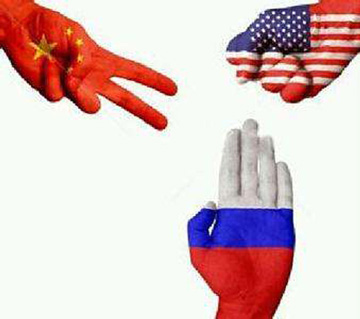Faced with the countless issues on which the U.S. China might conflict, it is difficult to even begin to think about how international cooperation may emerge. Xia Liping, Dean and Professor of the School of Political Science & International Relations at Tongji University in Shanghai, wisely pointed out while I was guest lecturing there, that if cooperation will emerge, it should emerge where the benefits of cooperation are most easily evident: in global public commons that require cooperation for them to be maintained and enjoyed by all. He surmised that the more great powers begin to cooperate on global commons – the polar regions, the oceans, outer space and the environment that provides the air we breathe – the more likely great powers would come to work together on smaller and more tactical matters. Or, in other words, start cooperation with the big picture items that affect us all.

Operationalizing this logic is the hard part, especially since the few international organizations designed to create cooperation among nations – such as the United Nations – are often bogged down in dealing with the “small picture” or more short-term important problems: resolving border disputes, civil wars, assisting refugees, etc. Developments in the realms of outer space and energy/environment now present us the opportunity for three of the world’s great powers – China, Russia and the United States – to increase significantly international cooperation in the long run for two of the four global public commons: space and energy/environment. However, such improvements will not happen unless leaders in Washington, Beijing, and Moscow rethink historical notions of competition and conflict among them.
Space
First, myopic and self-destructive Congressional restrictions on Sino-American space collaboration should be abandoned. A chorus of experts and former officials, including Charles Bolden and George Abbey, have concluded that both the United States and China would benefit from cooperation in space exploration. The director of China’s National Space Administration, Xu Dazhe, has expressed similar sentiments, indicating that China is ready and willing to collaborate with NASA.
The Sino-American space cooperation ban purportedly stems from the “dual-use” nature of 90% of space technology. American fears of Chinese space militarization were stoked in 2007 when China launched a successful ASAT test, registering a kinetic kill on a defunct Chinese satellite. Following near-unanimous international condemnation of the test, however, China has not attempted another ASAT test, instead testing its kinetic kill capacity under the auspices of “missile defense tests” in accordance with international norms. China’s conciliatory response to condemnation of the 2007 ASAT test suggests that even if Beijing did gain access to American military technology, their deployment of such technology could be constrained by the same international norms that bind the United States. Dr. Joan Johnson-Freese at the US Naval War College has further noted that, in cooperating with China, the United States could itself gain information critical for deciphering the military uses of Chinese-developed space technology, a perennial vulnerability in American intelligence.
Plainly said, it is in the interest of the human race for China to join the successful Russo-American dialogue concerning the peaceful use of space. That Russian spacecraft continue to deliver American astronauts to the ISS despite icy ties between Washington and Moscow demonstrates that space cooperation has the potential to keep dialogue open between states even as relationships sour back on earth. With space collaboration as a “fallback forum,” Beijing and Washington might more transparently pursue their respective interests in other multilateral fora such as the Strategic and Economic Dialogues, to the benefit of both states.
Inviting China to join the ISS is the obvious first step towards Sino-American space cooperation, a critically important one, even as China is moving to eventually replace the ISS, with inevitable contributions from America’s space partners. China plans to launch its own space station in 2020, which will likely become the world’s de-facto space station after the ISS stops operating sometime after 2024. China has developed its own unique docking technology for space modules instead of committing to the current standard being developed in the US and Europe. Thus, American failure to cooperate with China in the short-term could negate the possibility of long-term collaboration, dealing a significant blow to humanity’s chances of avoiding a mutually harmful militarization of space. Furthermore, cooperation on developing terrestrial space stations between the three great spacefaring powers – China, the US and Russia – also makes much more likely the future human exploration of Mars, a project likely so costly as to be beyond the reach of any one of the three great space powers.
Energy/Environment
The cities of Northeast China, cloaked in a smog so noxious that its effects downwind have been registered on the American West coast, have dramatically slashed coal consumption in the past two years. Beijing currently seeks cleaner energy to replace that previously provided by coal, correcting a very costly mistake in national economic development that saw renewable energy directed toward South and East China, leaving the north dependent on plentiful and yet poisonous domestic coal. Given China’s cozy relationship with Russia, and the proximity of Northeast China to vast Siberian gas reserves, the initiation of a Sino-Russian energy partnership seems inevitable. In May 2014, Gazprom and CNPC finally signed a binding agreement on the Power of Siberia (POS) pipeline, which should transport 38bcm/year of Siberian gas to Northeast China as soon as 2020.
The linking of Siberian gas supplies to Northeast Chinese cleaner energy demand is a critical step towards the integration of an East-Asian spot market for gas, which would have stabilizing effects on both geopolitics and geo-commerce. In the LNG age, incorporating currently unexploited Siberian gas into an East-Asian spot market would deepen the liquidity of gas markets worldwide, thus insulating both producers and consumers from price shocks, and softening the blow such shocks might deliver to the global economy. Second, in a spot market for gas, unlike traditional gas markets, a singular producer, in this case Russia, is not able to manipulate gas volumes and prices in pursuit of foreign policy goals. The diversity of supply inherent in a spot market further enhances each individual consumer’s energy security. Especially as Japan demands less gas amidst Tokyo’s resumption of nuclear power generation, a spot market would create lower gas prices in the region, which will in turn enhance economic growth. Finally, as gas power replaces coal power in China, air quality should improve, as it has in the United States and elsewhere.
There are, however, several impediments to Sino-Russian gas cooperation, and thus the formation of an East Asian spot market for gas. First, Chinese notions of energy security dictate that Beijing will refuse to import massive volumes from any single gas supplier, including in this case, Russia. Second, North Korea’s presence in the middle of the East Asian spot market presents unique challenges to the inclusion of South Korea, a crucial customer/investor, in the market. Finally, the construction of POS itself is not guaranteed. The initial pipeline’s estimated completion has already been delayed by two years and Gazprom has slashed its 2016 expenditures on the project from 200 billion rubles to a meager 92 billion. Additionally, the Eastern Siberian fields that will feed POS, Chayanda and Kovykta, remain effectively undeveloped.
By applying the additional leverage of space cooperation to the formation of an East Asian gas spot market, Washington might compel Beijing to devote more resources to overcoming the above obstacles. To aid the development of an East-Asian gas market, Washington should encourage Beijing to make good on its reported prepayment of $25 billion to help Russia develop the Chayanda and Kovykta fields, insist on the addition of a Weihai-Incheon POS “spur,” under the Bohai Sea and develop east-coast LNG regasification capacity as-planned. Such developments would effectively link substantial onshore gas supplies from both Russia and Central Asia, and LNG supplies from Qatar and Australia to Northeast China, to the existing LNG receiving terminal network of the southern half of the Korean Peninsula. Stronger gas ties between China and Russia would thus contribute directly to South Korean energy security. Finally, no matter the political future of North Korea, it only strengthens the hand of Russia, China and South Korea in Six Party Talks with DPRK to have expanded natural gas capacity available to South Korea. Metaphorically speaking, US-Chinese-Russian cooperation on natural gas in East Asia moves a large basket of Russian carrots through the Chinese market to a part of the Korean Peninsula that currently has plenty of sticks and not enough carrots.
By cooperating with China in space, and leveraging this cooperation to allay Beijing’s concerns about establishing a spot market for gas in East Asia, the United States stands to improve geopolitical and geo-economic stability, to increase air quality in both Asia and the Pacific region, and to decrease the likelihood of the peaceful utilization and exploration of space. Contrary to hawks in Washington DC, Beijing and Moscow, fostering the joint provision of global public goods that benefit all is the most logical way to diminish the likelihood of future conflict.

